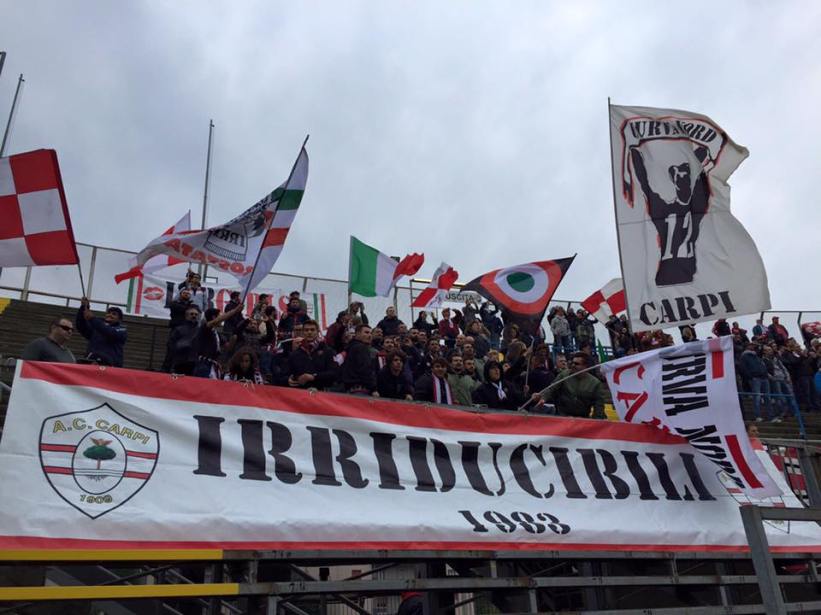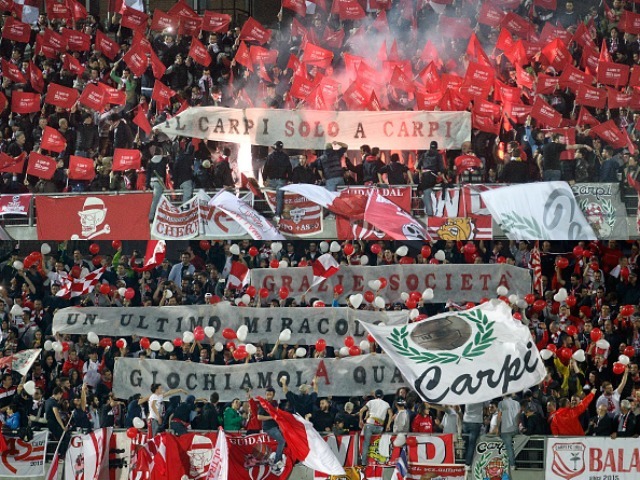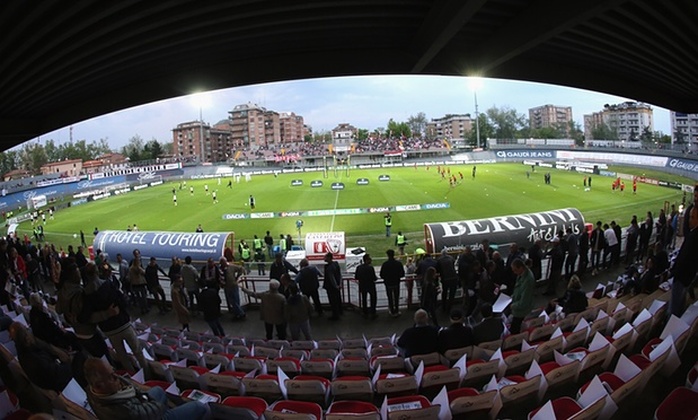Stadium: Stadio Alberto Braglia (Modena), capacity 21,151
It’s one thing when your fierce rivals have a stadium that is four times the size of your own. It’s another thing entirely when you are made to use this ground because you’ve been promoted to Serie A and they haven’t. The situation is not ideal for Carpi but, in the whole scheme of things, they have performed a miracle and now have a new home to showcase their talent.In an ideal world the team may have preferred to stay in the Stadio Sandro Cabassi in Carpi itself, but it only holds 4,760 spectators and did not meet Serie A requirements. Their stadium, which has been Carpi’s home since 1928, is typical of the arenas built at that time in Italy. It looks cold and grey, with the only colour coming from the supporters’ red and white flags. Despite its low capacity, the fans have provided huge support to the team and have created a distinctive atmosphere on the Curva Ovest. This will be missed as they move to Modena. It will be interesting to see how many of their fans will travel.
The Stadio Alberto Braglia, which they will be sharing with Modena FC from this season, is not your average Italian ground. The 21,151 spectators are close to the pitch in the ground’s four stands. The design is modern and the floodlights rise high in all four corners of the ground; the arena would not look out of place in England, Germany or Belgium.
The pitch has changed this summer, with the old grass being replaced with “Mixto hybrid grass technology’. This new surface will offer a different challenge for opponents, just as Cesena’s Stadio Dino Manuzzi and Novara’s Stadio Silvio Piola did some years ago in the top flight. If Carpi take to the new material quickly, they could developed a strong home advantage, as not all teams (if any), enjoy playing on synthetic surfaces.
If emotion is taken out of the equation, the Stadio Alberto Braglia is a good place for Carpi to play their football. Despite the town only having 70,000 inhabitants, it could still draw a sizeable crowd and the locals may also take the opportunity to watch some of the bigger clubs in Serie A.
The multi-purpose arena is ahead of its time it Italy. Rage Against the Machine, U2, Guns and Roses and Pink Floyd are just a few of the bands who have performed in the ground, and the Italy rugby union team played Fiji there in 2010. It is one of the more functional grounds on the peninsula. The danger for the small promoted club, is that they could be playing in to fans who are not supporting them on a pitch they have not yet adapted to. The situation is a precarious one.
The Ultras
“Sassuolo? Ma per favore…” It was a brusque response, but one the question probably merited. In many ways, the story of Serie A newcomers Carpi FC 1909 is comparable to that of US Sassuolo. Both clubs hail from small towns in Emilia Romagna. Both have humble footballing traditions and modest followings. Much of their history has been spent in the lower divisions. Their respective paths to Serie A have been plotted recently and rapidly, both winning a string of promotions in the last decade. Both have found that with success comes sacrifice, the duo having been forced to abandon their tiny 4,000-seater homes to comply with Serie A’s regulations.Sassuolo made their Serie A debut two years ago away to Torino. Since then, the Neroverdi have consolidated, negotiating two successful seasons. Carpi will make their first outing in Italy’s top tier on 23 August at Sampdoria. The Carpi president, Claudio Caliumi, has said that he sees “similarities” between the clubs and admitted that Sassuolo can be viewed as a “model” for Carpi. But do the Irriducibili of Carpi’s Curva Nord see Sassuolo as an example of hope for their Serie A campaign? “Sassuolo?” they reply, “…please.”
Flanked by the 52 arches of the Portico Lungo, the Piazza dei Martiri is Carpi’s central showpiece. It is the third largest square in Italy, yet with a population of around 70,000, the town that envelops this stately piazza is small and unassuming. Resting just 20km north of Modena, Carpi’s array of towers, turrets, palaces and renaissance art make it the perfect day-trip for culture-hungry tourists. Traditionally there has been no prominent sporting culture. But this all changed when Carpi FC took Italian football by storm, embarking on a meteoric rise from Serie D to Serie A in the space of six years.
Founded in 1909, Carpi have an undistinguished history. If you delve deep enough, records show they competed in Italy’s former top flight for three years between 1919 and 1922. Since then, there has been little to shout about in this province of Modena. That’s not to say Carpi haven’t threatened to establish themselves.
In the late 1970s, the Biancorossi (red and whites) celebrated promotion to Serie C and with it the birth of their first ultras group, Panthers. However, this foray did not last long. In 1980 their relegation back to Serie D was compounded by the contrasting fortunes of bitter rivals Modena, who won promotion from the same division.
For Carpi and their nascent ultras, this signalled the beginning of some trying years. Serie D had just been renamed Il Campionato Interregionale, a title instantly recognisable to those who have used Italy’s railroads. Documenting his experiences on the peninsula’s trains in his book Italian Ways, the author Tim Parks describes the Interregionale service as “the train of the living dead”. It seems football’s equivalent wasn’t much better. One Carpigiano was particularly disparaging, calling the division “unattractive and squalid”.
As a consequence, some Carpi fans looked elsewhere. Bologna and Reggiana provided logical choices. Both were from Emilia Romagna and both regularly locked horns with Modena. But during this adversity, groups of stalwarts emerged.
The Irriducibili were formed in 1983 and were followed by Mucchio Selvaggio(Wild Bunch). Members of the Irriducibili recall the sparse attendances and the struggle to maintain unity at the Stadio Cabassi. “It wasn’t easy during the dark years,” they say. “However, thanks to those who continued to gather both inside and outside the stadium, we managed to keep the movement alive.”

The Irriducibili remain flag-bearers, alongside Guidati dal Lambrusco, whose name is inspired by the locally produced wine. Formed in 1989, Guidati’s arrival coincided with a turn in fortunes for Carpi as two consecutive promotions propelled them into Serie C1. These were exciting times for the minnows. With professional football came certain novelties. Every week, Carpi were featured on Rai TV’s iconic football show, Domenica Sportiva, while fans had the pleasure of placing their beloved city on their Schedina (betting slip).
The highlights of the 1990s included a historic 1-0 victory over Emilian giants Bologna in 1993-94 and a run to the Serie C1 play-off final in 1997. Over 4,000Carpigiani watched their team narrowly miss out on a historic promotion to Serie B after they lost 3-2 to Monza. In hindsight it was the precursor for future conquests but first there was humiliation. In the words of the Irriducibili, “A succession of mistakes culminated in bankruptcy in 2000.” Carpi were forced to start again in the amateur Eccellenza division.
Two years later, coach Raffaello Papone engineered the Biancorossi’s return to Serie D. Having made over 200 appearances for the club, Papone shared the supporters’ passion and commanded respect. Enthusiasm began to creep back. According to the Irriducibili, the crucial turning point came in 2005. “The revival began with the arrival of Claudio Caliumi as president and the consequent merger between Carpi and Dorando Pietri [another team from the town]. This was the catalyst for our promotions from Serie D to Serie A.”
Like Papone, Caliumi was also a former player who had gone on to become a successful local entrepreneur, creating a womenswear brand. He remains owner today, alongside fellow entrepreneurs Stefano Bonacini and Roberto Marani. Under their stewardship, Carpi have reshuffled Calcio’s pack, producing a remarkable four of a kind. These four promotions between 2009 and 2015 have proved both inspiring and timely for the people of Carpi, who endured the hardships of a 5.8 magnitude earthquake that struck in 2012, as well as the travails of the textile industry, upon which the town is heavily reliant.
Yet Carpi’s rise to Serie A has captured the imagination and garnered widespread support, something which has often been lacking. Before their home game against Bari in April 2015, the Curva Nord choreographed a spectacle. Supporters held aloft red and white placards adorned with the letter “A”. Amid the flash and smoke of flares and firecrackers, they unfurled a banner that read: “Conquisti amol…” “Conquer it [Serie A]”. The game finished 0-0, mathematically ensuring Carpi’s promotion to Serie A and the sell-out crowd streamed on to the pitch to celebrate with their heroes.
For the Irriducibili, the spectacle before the game was as great a signifier of the club’s progress as the promotion itself. “There was incredible enthusiasm and emotion when we reached Serie A, however, our biggest satisfaction was seeing our Curva grow.”
Having gleefully left Modena behind in Serie B, the Carpigiani will renew acquaintances with an old foe in Serie A. “The fixture we are most looking forward to? Empoli” say the Irriducibili. “We have old grudges that date back to the 1990s and these were revisited during our first year in Serie B.”
But Serie A brings with it a more pressing issue. During the game against Bari, the ultras also unveiled a banner reading “Grazie Societa. Un Ultimo Miracolo. Giochiamo la A Qua” (“Thank you owners. One last miracle, let’s play Serie A here”). The decision to move from the Stadio Cabassi to their enemy’s Stadio Alberto Braglia has split opinion.
The group Guidati dal Lambrusco have already announced they will not be buying season tickets for Modena, deciding only to travel to away games. “This place will never be our home,” they say. The Irriducibili seem unperturbed. “Where we play next year or the years after doesn’t interest us. We follow Carpi wherever and the actions of other groups don’t bother us in the slightest.”
The group’s differences are also mirrored in politics. From 2003, the Guidati dal Lambrusco began to participate in the “Mondiali Antirazzisti”, a multi-cultural festival that brings together hundreds of supporters, football clubs and nationalities in a fight against discrimination.
The Irriducibili choose not to participate in any such events and have expressed contrasting views: “We think politics should remain outside the stadium but, given that this isn’t the case in almost every Curva in Italy, we are also politically inclined. The majority of our group are right-wing but there are also differing ideologies within the group that upset the balance of the Curva.”
Carpi will need all the support they can find to keep their fairytale alive. For what might be considered a miracle by some is regarded a nightmare for others. In a leaked telephone call published by Italian newspaper La Repubblica, Lazio president Claudio Lotito bemoaned the promotion of small clubs such as Carpi and fellow Serie A debutants Frosinone. He claimed that hardly anyone knew who they were and that TV revenue could be jeopardised “if teams come up [to Serie A] who are not worth a cent”.
The Lazio president’s comments were met with a sardonic riposte on the Carpi official website. “Perhaps it’s true, as we read in the media, that some people don’t even know Carpi exists,” the statement read, “but like it or not, we do!” Lotito’s business-centric outlook is symptomatic of the modern game and theIrriducibili do not think he is the only one with such supercilious views. “Lotito said what all the other presidents in Serie A were thinking but didn’t want to say.”
Yet what others say and do is of little import to Carpi and their supporters. This brings us back to the ultras’ curt response when asked to compare their club to Sassuolo. Carpi’s formula for success has been unique. At their nadir, they instilled faith in the old guard, using former players to start the rebuilding process.
Mistakes have been heeded and president Caliumi has kept the club in the green. The club reportedly recorded a turnover of €3.15m in their most recent accounts, while the squad that won the Serie B title was compiled for an overall cost of €1.82m. In comparison to Sassuolo – who are backed by the resources of manufacturing magnate Giorgio Squinzi – Carpi have been parsimonious.
They have carved their own identity and will bring their own brand to Serie A. These are pioneering times, yet it has taken years of patience and endeavour to reach this point. On an August afternoon in Genoa, the stage will be set for Carpi to write the next chapter in their history. At their backs, they will hear the vocals of their most staunch supporters.
“Our objective for this season is to continue to grow and encourage as many people as possible to love our colours,” the Irriducibili conclude. “But whatever happens, we will consider this season a success.”
Classic player: Salvatore Bagni
“I was going to quit. There was no one who believed in me. I might as well just do it I thought. The only one who had faith was George Forghieri, my coach. He insisted that I did the summer camp with Carpi. It was luck, because everything was born there almost by accident.” Salvatore Bagni
A career that spanned over 400 games plus an additional 41 for the national team started from this moment in Carpi. Salvatore Bagni, later to be known as “The Warrior” definitely made the right choice by going to summer camp. From here a distinguished career at Carpi FC saw him transported to Perugia, Internazionale and Napoli before he retired with Avellino.
Carpi may not boast a plethora of big-name stars who have gone on to great things but the ones they have are memorable. Marco Matterazzi spent the 1996/97 season there, making 17 appearances and scoring a remarkable seven goals. Simone Inzaghi also turned up on loan in 1995 but did not score in his five appearances. Chievo legend Salvatore Lanna also played 30 times for the club before moving on, but none of them had the impact of Bagini.
Correggio is a little town in Emilia-Romagna in the Po valley and it was here that in 1956 little Salvatore was born. Despite the early doubts over his ability, he signed a professional contract with the club in 1975 and never looked back. This industrious central midfielder would end up playing alongside Maradona at Napoli but this was not even in his thinking right now.
Bagini’s story is one that revolves around that first contract he signed at Carpi FC. He thought of it as one of the most important moment of his career and the confidence he took from it gave him the belief to become the player he was.
Bagini was a tough central midfielder who would be able to stay on the field for five minutes if he played today. His tacking was hard, not always fair and in the lower echelons of Italian football he learnt how to fight. In his early years at Carpi FC, however, he was often deployed on the wing or up front and it was here that he honed his skills and more importantly his USP, his goalscoring ability.
In 61 appearances for Carpi FC he scored 23 goals, this was some return and this ability was not lost as he moved up the leagues. At Perugia he scored 29 in 109, at Inter 12 in 82 and at Napoli, 12 in 129. He even managed to score 5 in 41 for the Azzurri which is impressive as he moved deeper and deeper throughout his career.
The Warrior took pride in his lower league status. This fuelled him and he perhaps over-compensated with harder challenges or more outlandish behaviour that often saw him disciplined. The man who would win the league with Maradona’s Napoli in 1986 and would feature in the World Cup of the same year was arguably taking on the image of a tough lower league player more as his career progressed. Ironically, he played some of his more beautiful football at Carpi.
As Carpi FC move into the elite level of Italian football, Bagini will look on with pride. He will no doubt relive and retell the stories of when he played for the club in the dark days and perhaps rightly assume he is their most famous export. In many ways the club is built in his image. They are proud of their roots, are perhaps worried about belonging, but are ready to fight. They also have a bit of talent in there as well.




Carpi faces challenges but embraces opportunities in their new stadium. A modern venue with potential for growth and a chance to shine!